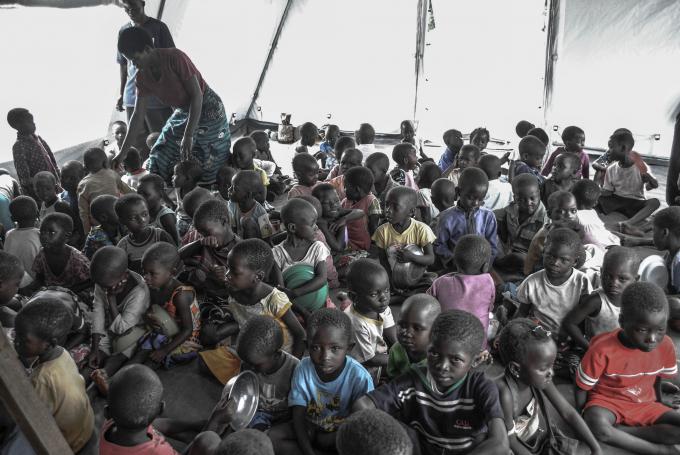Saving Children Through CBCC's - Flood Response
Homes swept away like grass. Farms, huge farms, turned to mud, fields of precious crops drowned. Thousands of livestock gone unaccounted for. Human lives lost. Families separated leaving children unaccompanied.
Children here speak of having climbed up trees and waiting for hours, some for days without food or water, drenched in rain and fearing attack by crocodiles. Women describe how they have lost everything. This is the story of most displaced villagers in Nsanje district of southern Malawi, one of the few districts heavily affected by the floods. These villagers are now seeking refuge in camps. One such camp is MOTA Engil in Nsanje Boma.
The camp at MOTA Engel covers over five Group Villages from two Traditional Authorities (TAs) in Malemia, Mgabu and Nyachikadza. There are over 3,000 people at this camp, all with different tales to tell. Some have come from as far as Mozambique.
As we approach one of the tents that house the Community Based Childcare Centre’s (CBCCs), a familiar sound of excited children, singing on top of their voices, welcomes us. Outside the tent, women are seen going about their various errands and activities. The only children outside the tents are those on the backs of their mothers. The rest, as I am told later on, are in the classes.
“Today we are taking them through a process of telling stories and thoughts through drawings.” remarked Commence Tembo, one of the CBCC caregivers at this camp who have been mobilised and trained by Save the Children.

Inside the tent, a group of over 60 children within the age range of 4 to 6 years old are busy listening to their instructors. The look on their faces reveals that they are enjoying the sessions. Here and there, I could see others singing and dancing while others were busy drawing.
Enala Kamanga, Early Childhood Development facilitator for Save the Children responding to the emergency in the district says that Save the Children has been very central in ensuring that the safety and well being of these children in these camps is guaranteed. “Our focus dwells much on child protection. This is why we have these sessions on a daily basis. Children meet from 7:30 am to 10:30 am,” she stressed.
“Initially we had problems to bring the children together as the floods had left a huge impact on them. Most of them were psychologically affected. They could not even gather in groups. Each one spent most of the time with their parents,” she adds.
“However, this time around we have managed to have all the children put in groups where they attend their CBCC classes and go through psychosocial support services. We have two different groups. One for those aged 3 to 5 and the other group aged between 5 to 6,” Enala explained.
Back in the classroom, the children are all engaged and participating. The instructors are busy giving instructions. “We consider all the four aspects of growth, in an interactive way, when preparing lessons for the learners,” remarked Commence. Of the four aspects – spiritual, intellectual, physical and social, the learners seem to enjoy much of the social. “Our aim is to make sure there is the cohesion during these times. That the children do not feel destructed and affected by the displacement,” added Enala.
During break-time, the children receive porridge prepared by volunteers. A group of at least eight women volunteered to form a committee that looks into managing food, most of which is porridge, for these children attending lessons here. One volunteer, Eliza Kapito, aged 60 said that the women are very cooperative in their committee. She says that Save the Children helped in mobilising them about the issue of CBCCs and facilitated the formation of the committee. They made their own decisions about how the committee will be run.
“Every member volunteered to be contributing whatever they can manage towards the collection of firewood,” she explained. “Not only that, every parent is supposed to contribute towards firewood but there is still some resistance from other parents especially those with no children in the CBCCs,” she added.
In the district, Save the Children has also mainly focused on tracing children separated from their parents due to the floods and re-unifying them with their families; finding alternative care for children who lost parents and relations. Save the Children also provides play materials for the children in CBCCs and psychosocial support to child learners.
“The aim is to bring the children together so that they are protected from any kind of exploitation and abuse. While we may not be able to prevent disasters from taking place, we can do much more to mitigate their impact on children and this is one such a way,” Tumbikani Kaonga, Save the Children Coordinator for the district told us. “We also deal with abuse cases where we have put in place protection mechanisms for any abuse to be reported and necessary referrals to be done.” added Tumbikani.
At close inspection outside the tents, we could see specially made outdoor banners to indicate safe spaces where children can get protection services. “We are also doing awareness meetings in the camps on child protection issues taking advantage of the existing gatherings ready during distribution of items.” Tumbikani affirms.
Save the Children, with support from UNICEF has supported children in over 19 such camps in Nsanje district. It has oriented caregivers and parents in the camps on how to produce locally made playing materials for children.
Written by Collins Mhango, Knowledge Management Officer
 Malawi
Malawi